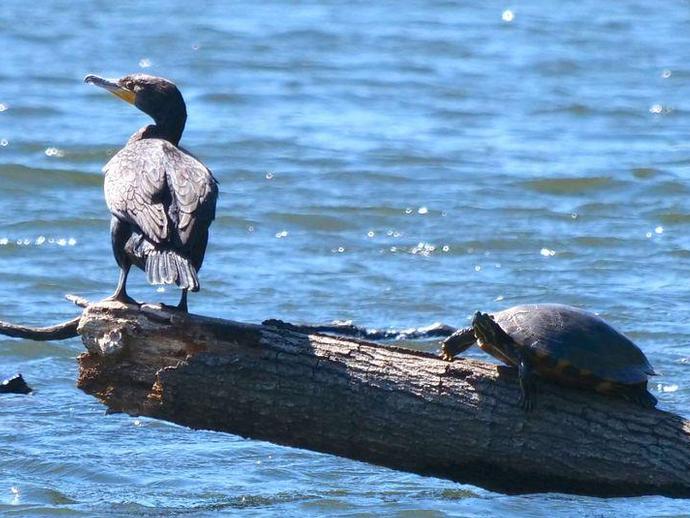May 19, 2021
Ben here with the Wednesday edition of #BenInNature presented by our friends at Carter Bank & Trust!
Here's another find from my recent trip to South Carolina: a double-crested cormorant (Phalacrocorax auritus), spotted at Brick Pond Park in North Augusta. And also its turtle friend.
Double-crested cormorants have a wide distribution and can be found almost everywhere in the U.S. depending upon the time of year. They can be found in Virginia during their migration season, but they're most easily spotted along the Virginia coast.
Much like the anhinga we looked at last week, the double-crested cormorant can often be spotted with its wings spread out to dry in the sun. They produce very little preen oil, which means their feathers get soaked with water instead of shedding it like a duck's feathers. While wet wings can make it harder for the double-crested cormorant to fly, it makes it much easier for the bird to submerge and hunt fish.
Much like the bald eagle (Haliaeetus leucocephalus), the number of double-crested cormorants decreased significantly in the 1960s due to the use of the pesticide DDT, which has a side effect of causing many different species of birds to lay eggs with thinner shells. The U.S. ban on DDT has allowed the population of double-crested cormorants to rise once more, but unfortunately, these birds are at threat once again due to bad science and misinformation.
Both the U.S. Fish and Wildlife Service and the Canadian government have allowed certain localities to cull double-crested cormorants and nests, mainly in areas surrounding the Great Lakes. This is because some fishing groups have argued that the increasing numbers of cormorants are causing a decline in various sport-fish. In truth, it's unlikely that the cormorants are having that much of an impact. Even if they were, it's never wise for humans to meddle with the natural order. As we've seen time and time again in this space, it almost always has negative unintended consequences.
ABOUT #BenInNature
Social distancing can be difficult, but it presents a great opportunity to become reacquainted with nature. In this series of posts, Administrator of Science Ben Williams ventures outdoors to record a snapshot of the unique sights that can be found in the natural world. New updates are posted Monday - Friday, with previous posts highlighted on the weekends. This series of posts is made possible thanks to the support of VMNH Corporate Partner Carter Bank & Trust (www.cbtcares.com).
NATURE PHOTO IDENTIFICATIONS
If you discover something in nature that you would like help identifying, be sure to message us right here on Facebook with a picture (please include location and date of picture) and we'll have our experts help you identify it!

 Hours & Admissions
Hours & Admissions Directions
Directions

